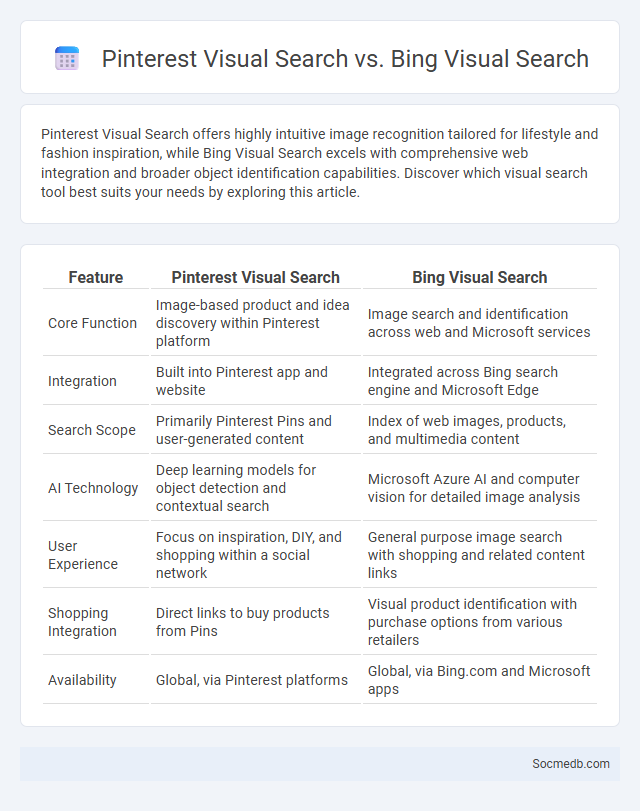
Photo illustration: Pinterest Visual Search vs Bing Visual Search
Pinterest Visual Search offers highly intuitive image recognition tailored for lifestyle and fashion inspiration, while Bing Visual Search excels with comprehensive web integration and broader object identification capabilities. Discover which visual search tool best suits your needs by exploring this article.
Table of Comparison
| Feature | Pinterest Visual Search | Bing Visual Search |
|---|---|---|
| Core Function | Image-based product and idea discovery within Pinterest platform | Image search and identification across web and Microsoft services |
| Integration | Built into Pinterest app and website | Integrated across Bing search engine and Microsoft Edge |
| Search Scope | Primarily Pinterest Pins and user-generated content | Index of web images, products, and multimedia content |
| AI Technology | Deep learning models for object detection and contextual search | Microsoft Azure AI and computer vision for detailed image analysis |
| User Experience | Focus on inspiration, DIY, and shopping within a social network | General purpose image search with shopping and related content links |
| Shopping Integration | Direct links to buy products from Pins | Visual product identification with purchase options from various retailers |
| Availability | Global, via Pinterest platforms | Global, via Bing.com and Microsoft apps |
Introduction to Visual Search Technologies
Visual search technologies use artificial intelligence to analyze images and identify objects, locations, and patterns, enhancing social media experiences by enabling users to search visually rather than through text. Platforms like Instagram and Pinterest integrate these technologies to allow users to discover products, replicate styles, and access related content seamlessly. By leveraging computer vision and deep learning, visual search improves content discoverability and user engagement across social media networks.
What is Pinterest Visual Search?
Pinterest Visual Search is an advanced image recognition tool that allows users to find similar items or related content by selecting a specific part of any image on the platform. It uses machine learning algorithms to analyze the selected area and delivers relevant pins, products, and ideas directly connected to the chosen visual element. This feature enhances user engagement by simplifying product discovery and inspiration through visual cues rather than text-based queries.
What is Bing Visual Search?
Bing Visual Search is a powerful tool that allows you to search the web using images instead of text, enhancing your social media experience by quickly finding related content and products. By simply uploading a photo or using an existing image, Bing Visual Search identifies objects, landmarks, and even products within the picture, delivering accurate and relevant results. This feature streamlines your ability to discover new trends, similar visuals, and useful information, making your social media browsing more interactive and efficient.
Overview of General Visual Search Solutions
Visual search solutions leverage image recognition technology to enable users to find information using pictures instead of text queries on social media platforms. These tools analyze visual content to identify objects, brands, and scenes, enhancing user engagement and streamlining product discovery. Your experience on social media becomes more intuitive as these solutions improve accuracy and speed in matching images to relevant content.
Accuracy and Performance Comparison
Social media platforms vary significantly in data accuracy and performance, with Facebook offering robust algorithms for targeted content delivery and real-time analytics tracking user engagement metrics like click-through rates and conversion percentages. Twitter emphasizes speed and immediacy, providing accurate trend analysis through hashtags and real-time interaction data but with limitations in deep demographic segmentation. Instagram combines visual content optimization with precise audience insights using AI-driven image recognition, resulting in high-performance advertising campaigns and detailed performance comparison tools.
User Experience and Interface Differences
Social media platforms prioritize user experience through intuitive interfaces designed for seamless navigation and engagement. You encounter variations in layout, content presentation, and interaction elements across different platforms, which influence how efficiently you can access features and connect with others. Understanding these interface differences enhances your ability to choose the platform that best suits your communication and content consumption preferences.
Integration with Shopping and E-Commerce
Social media platforms increasingly integrate shopping features, enabling users to browse and purchase products without leaving the app. Instagram Shopping and Facebook Shops offer seamless checkout experiences, boosting e-commerce conversion rates by leveraging targeted advertising and influencer partnerships. This integration enhances brand visibility and provides businesses with direct access to engaged audiences, driving online sales growth.
AI and Machine Learning Capabilities
Social media platforms increasingly integrate AI and machine learning algorithms to enhance user experience by personalizing content feeds, detecting harmful behavior, and optimizing ad targeting. Machine learning models analyze vast amounts of user data to predict preferences, improve recommendation systems, and automate content moderation with high accuracy. Advanced AI capabilities enable real-time sentiment analysis and trend prediction, driving engagement and providing valuable insights for businesses and marketers.
Use Cases and Popular Applications
Social media platforms serve diverse use cases, including brand promotion, customer engagement, and community building, essential for your business growth. Popular applications like Facebook, Instagram, Twitter, LinkedIn, and TikTok offer tailored features for content sharing, live streaming, and targeted advertising to maximize user interaction. Leveraging these platforms effectively enhances your online presence and drives measurable results in marketing and communication strategies.
Future Trends in Visual Search Technology
Visual search technology is transforming social media by enabling users to discover products and information through images rather than text. As AI and machine learning algorithms evolve, future trends will include real-time image recognition, personalized content recommendations, and enhanced augmented reality experiences. Your interactions on social platforms will become more intuitive and immersive, driven by seamless integration of visual search tools.
 socmedb.com
socmedb.com